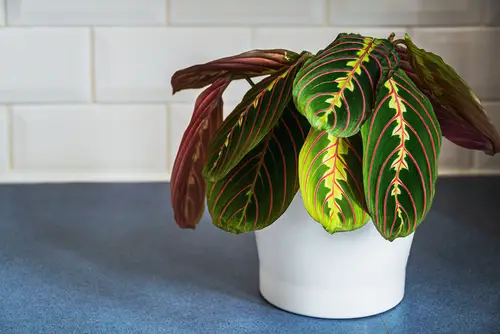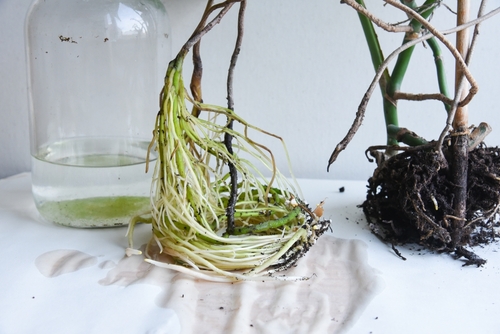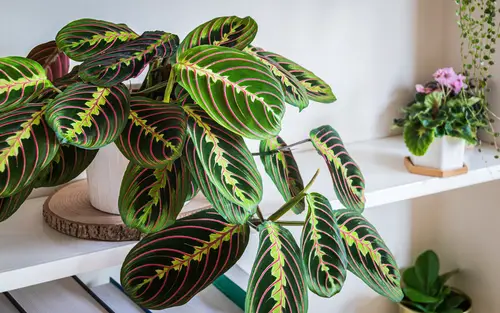Prayer plants are a popular choice for indoor gardening enthusiasts, thanks to their attractive foliage and relatively low maintenance requirements. However, one common problem that can occur with prayer plants is the yellowing of their leaves. This can be a frustrating issue for plant owners, as it can be difficult to pinpoint the exact cause of the problem.
Understanding prayer plants is an important first step in addressing yellow leaves. These plants are native to the tropical regions of Central and South America and require specific environmental conditions to thrive.
They are known for their unique leaf movement, which sees their leaves fold up at night, resembling hands clasped in prayer. Prayer plants require bright, indirect light, high humidity levels, and well-draining soil to flourish.
There are several common causes of yellow leaves on prayer plants, including watering issues, soil and fertilizer factors, light and temperature conditions, humidity and moisture levels, and disease and pest problems.
Identifying the specific cause of yellow leaves can be challenging, but careful observation and attention to care and maintenance can help prevent or address the issue.
Key Takeaways on Prayer Plant Leaves Turning Yellow
- Understanding prayer plants is key to preventing yellow leaves.
- Watering, soil, light, temperature, humidity, and pests can all cause yellow leaves on prayer plants.
- Proper care and maintenance can help prevent and address yellow leaves on prayer plants.
See these other top picks:
- Why Are My Soybeans Turning Yellow?
- Why Are My Pilea Leaves Turning Yellow?
- Why Are My Oriental Lily Leaves Turning Yellow?
Understanding Prayer Plants

Prayer plants, also known as Maranta leuconeura, are a popular houseplant due to their unique foliage and ease of care. These plants are native to the tropical regions of Central and South America and are known for their striking green foliage and nyctinasty movement, which causes the leaves to fold up at night.
Prayer plants are part of the Marantas family, which includes several other species of plants with similar characteristics. These plants typically have broad, oval-shaped leaves with intricate patterns, making them a popular choice for indoor decoration.
One of the most interesting features of prayer plants is their nyctinasty movement, which is a natural response to changes in light. At night, the leaves of prayer plants fold up, creating a unique and eye-catching display. This movement is caused by changes in the turgor pressure of the cells in the plant’s leaves.
While prayer plants are relatively easy to care for, they can be susceptible to a variety of issues, including yellowing leaves. Understanding the causes of yellowing leaves can help you keep your prayer plant healthy and thriving.
Prayer Plant Leaves Turning Yellow – 5 Common Problems
Yellow leaves on a prayer plant are often a sign of an underlying issue. Here are some common causes of yellowing leaves:
1. Environmental Stress
Environmental stress is one of the most common causes of yellowing leaves on prayer plants. This can include exposure to cold temperatures, low humidity, or too much direct sunlight.
Prayer plants prefer warm, humid environments with indirect light. If the plant is exposed to cold temperatures or direct sunlight, the leaves can turn yellow and eventually brown.
2. Overwatering
Overwatering is another common cause of yellow leaves on prayer plants and can lead to root rot. If the soil around the plant feels waterlogged, then overwatering is likely to blame. To fix this issue, allow the soil to dry out before watering again. It’s also important to ensure the plant is in a well-draining pot.
3. Underwatering
Underwatering can also cause yellowing leaves on prayer plants. If the soil is too dry, the leaves can wilt and turn yellow. To fix this issue, water the plant thoroughly and ensure the soil stays moist but not waterlogged.
4. Pests

Pests such as spider mites or mealybugs can also cause yellowing leaves on prayer plants. These pests can sap the plant’s nutrients and cause the leaves to turn yellow or brown. To fix this issue, use an insecticidal soap or neem oil to get rid of the pests.
5. Disease
Diseases such as bacterial or fungal infections can also cause yellowing leaves on prayer plants. These diseases can cause brown spots or scorch marks on the leaves, as well as curling or wilting. To fix this issue, remove any affected leaves and ensure the plant is in a well-ventilated area to prevent further spread of the disease.
Watering Issues
Proper watering is crucial for the health of your prayer plant. Overwatering, underwatering, poor water quality, and standing water are the most common watering issues that can cause yellow leaves on your prayer plant.
1. Overwatering
Overwatering is the most common cause of yellow leaves on prayer plants. When the roots of the plant sit in water for too long, they become waterlogged and can’t absorb nutrients properly. This can lead to root rot, which can cause yellow leaves and other problems.
To avoid overwatering, make sure your prayer plant is in a pot with drainage holes. This will allow excess water to drain out of the soil. Also, make sure to empty the saucer under the pot after watering to prevent standing water.
2. Underwatering
Underwatering is another common cause of yellow leaves on prayer plants. When the soil is too dry, the plant can’t absorb enough water and nutrients, which can cause the leaves to turn yellow.
To avoid underwatering, make sure to water your prayer plant regularly. The frequency of watering depends on the environment and the size of the pot. As a general rule, water your plant when the top inch of soil feels dry to the touch.
3. Poor Water Quality
Poor water quality can also cause yellow leaves on prayer plants. Tap water can contain chlorine, fluoride, and other chemicals that can harm your plant. Hard water can also cause mineral buildup in the soil, which can affect nutrient absorption.
To avoid poor water quality, use filtered or distilled water for your prayer plant. You can also let tap water sit out for 24 hours to allow the chlorine to evaporate.
4. Standing Water
Standing water can also cause yellow leaves on prayer plants. When the soil is constantly wet, it can lead to root rot and other problems.
To avoid standing water, make sure your prayer plant is in a pot with drainage holes. Also, make sure to empty the saucer under the pot after watering to prevent standing water.
Soil and Fertilizer Factors

Yellowing of leaves in prayer plant can be caused by soil and fertilizer factors. Here are some of the sub-sections to consider:
Soil PH
Prayer plants prefer slightly acidic soil with a pH range of 5.5 to 6.0. If the soil pH is too high, the plant may not be able to absorb nutrients properly and may show signs of nutrient deficiency, including yellowing of leaves.
It is recommended to test the soil pH using a soil testing kit and adjust it if necessary by adding sulfur or peat moss to lower the pH or adding lime to raise the pH.
Fertilizer Burn
Over-fertilizing or using a fertilizer with a high concentration of salts can cause fertilizer burn, which can lead to yellowing of leaves. It is essential to follow the instructions on the fertilizer package and avoid applying too much fertilizer.
If the plant is showing signs of fertilizer burn, flush the soil with water to remove excess salts and avoid fertilizing for a while.
Nutrient Deficiency
Yellowing of leaves can also be a sign of nutrient deficiency, including nitrogen, iron, or magnesium deficiency. Nitrogen deficiency can cause yellowing of older leaves, while iron deficiency can cause yellowing of younger leaves.
Magnesium deficiency can cause yellowing between the veins of the leaves. It is recommended to use a balanced fertilizer that contains all essential nutrients and to supplement with specific nutrients if necessary.s.
Light and Temperature Conditions
Insufficient Light
One of the most common reasons for prayer plant leaves turning yellow is insufficient light. Prayer plants require bright, indirect light to thrive. If the plant is not receiving enough light, its leaves may turn yellow or even brown. In this case, consider moving the plant to a brighter location, or supplementing its light with artificial lighting.
Excessive Light
While insufficient light can cause yellowing of prayer plant leaves, excessive light can also be a problem. If the plant is exposed to too much direct sunlight, it can scorch and burn the leaves. T
his can cause them to turn yellow or brown. To prevent this, ensure that the prayer plant is placed in a location that receives bright, indirect light, but is protected from direct sunlight.
Incorrect Temperature

Temperature also plays an important role in the health of prayer plants. These tropical plants prefer warm, humid conditions and do not tolerate cold temperatures well.
If the plant is exposed to temperatures below 55°F, it may suffer and its leaves may turn yellow. To prevent this, ensure that the prayer plant is kept in a location that remains above 55°F at all times.
Humidity and Moisture Levels
Prayer plants thrive in environments with high humidity and moist soil. When the humidity and moisture levels are not adequate, the leaves of the plant can turn yellow. In this section, we will discuss the impact of humidity and moisture levels on prayer plants and how to address issues related to them.
Low Humidity
Prayer plants are native to tropical regions, and they require high humidity levels to grow. Insufficient humidity can cause the leaves to turn yellow and brown. If you notice that the leaves of your prayer plant are turning yellow, it could be due to low humidity levels.
To increase the humidity levels around your prayer plant, you can use a humidifier or place a tray filled with water near the plant. You can also mist the leaves of the plant regularly to keep them moist. Another option is to group your prayer plant with other plants to create a more humid microclimate.
Excess Moisture
While prayer plants require moist soil, excessive moisture can lead to root rot and other issues. If the soil around your prayer plant is constantly wet, it can cause the leaves to turn yellow and wilt.
To address excess moisture, ensure that the soil around your prayer plant is well-draining. You can also reduce the frequency of watering and allow the soil to dry out slightly between watering sessions. Additionally, you can increase the airflow around your plant by placing a fan nearby.
Disease and Pest Problems
When prayer plant leaves turn yellow, it could be due to diseases or pest infestations. It is important to identify and treat these problems promptly to prevent further damage to the plant.
1,Root Rot

Root rot is a fungal disease that affects the roots of plants, including prayer plants. It occurs when the soil is too wet and does not drain properly, causing the roots to rot. Symptoms of root rot include yellowing leaves, wilting, and stunted growth.
To prevent root rot, make sure the soil is well-draining and avoid overwatering the plant. If root rot has already set in, remove the affected roots and repot the plant in fresh soil.
2. Fungal Diseases
Prayer plants are susceptible to several fungal diseases, including helminthosporium leaf spot. This disease causes brown spots on the leaves, which can eventually turn yellow and drop off. Another fungal disease that can affect prayer plants is powdery mildew, which causes a white powdery coating on the leaves.
To prevent fungal diseases, avoid getting water on the leaves when watering the plant, and make sure the plant has good air circulation. If the plant is already infected, remove the affected leaves and treat the plant with a fungicide.
3. Virus Infections
Cucumber mosaic virus is a common virus that can infect prayer plants. Symptoms of this virus include yellowing leaves, distorted growth, and mottled or streaked leaves. Unfortunately, there is no cure for virus infections, so infected plants should be removed and destroyed to prevent the virus from spreading to other plants.
Pest Infestations
Prayer plants can be attacked by several pests, including spider mites and mealybugs. These pests can cause yellowing leaves, as well as stunted growth and distorted leaves.
To prevent pest infestations, keep the plant clean and free of debris, and inspect the plant regularly for signs of pests. If the plant is already infested, treat it with neem oil or another insecticidal soap to get rid of the pests.
Care and Maintenance Tips
Taking good care of your prayer plant is essential to keep it healthy and prevent yellow leaves. Here are some tips to help you maintain your plant:
1. Repotting
Prayer plants require well-draining soil to thrive. Repotting your plant every year or two can help prevent soil compaction and provide fresh nutrients. When repotting, choose a pot that is one size larger than the current one and use a well-draining potting mix. Be careful not to damage the roots when removing the plant from its old pot.
2. Propagation

Propagation is a great way to expand your collection of prayer plants. You can propagate your plant by dividing the root ball or taking stem cuttings.
To propagate by division, gently remove the plant from its pot and separate the root ball into two or more sections. To propagate by stem cuttings, take a cutting with at least two leaves and place it in a container with water or moist soil.
3. Winter Care
Prayer plants are sensitive to cold temperatures and require warm and humid conditions to grow. During the winter months, it is important to keep your plant away from drafts and cold windows. You can also use a humidifier or place a tray of water near the plant to increase the humidity.
4. Troubleshooting
Yellow leaves can be a sign of many different issues, including overwatering, underwatering, incorrect lighting, and pest infestations. To troubleshoot yellow leaves, start by checking the soil moisture and adjusting your watering schedule accordingly.
If the leaves are turning yellow and crispy, your plant may be receiving too much direct sunlight. Move it to a location with bright, indirect light. If you suspect a pest infestation, inspect the plant for signs of bugs and treat as necessary.
Remember that prayer plants go through periods of dormancy and growth, and their care needs may change depending on the season. By following these care and maintenance tips, you can help your prayer plant thrive and enjoy its beautiful foliage year-round.
Conclusion
Yellow leaves on a prayer plant can be a sign of various issues, including overwatering, underwatering, too much sunlight, and low humidity. The best way to prevent yellowing leaves is to provide the plant with the right amount of water, light, and humidity.
If the prayer plant is overwatered, the roots can become waterlogged, leading to yellow leaves. On the other hand, if the plant is underwatered, the leaves will turn yellow and dry. It is essential to water the plant when the soil is dry to the touch and avoid overwatering.
Another reason for yellowing leaves is too much sunlight. Prayer plants prefer bright, indirect light, and direct sunlight can scorch and burn the leaves. If the plant is getting too much light, it is best to move it to a shadier spot.
Prayer plants also thrive in high humidity, and low humidity can cause the leaves to turn yellow. Placing the plant in a humid location or using a humidifier can help prevent yellowing leaves.
Frequently Asked Questions

What does an overwatered prayer plant look like?
Overwatering is a common cause of yellowing leaves in prayer plants. If your prayer plant is overwatered, the leaves may appear wilted and droopy, and the soil may be waterlogged.
You may also notice a foul odor coming from the soil. To prevent overwatering, make sure the soil is well-draining and only water the plant when the top inch of soil is dry.
How often should I water my prayer plant?
The frequency of watering your prayer plant will depend on various factors such as humidity, temperature, and the size of the pot.
Generally, it’s recommended to water the plant once a week, but make sure to check the soil’s moisture level before watering. Overwatering can lead to root rot, which can cause yellowing leaves.
Should I cut off yellow prayer plant leaves?
Yes, it’s recommended to remove yellow leaves from your prayer plant. Yellow leaves are a sign of stress or damage to the plant, and removing them can help the plant focus its energy on healthy growth.
Use clean and sharp scissors or pruning shears to cut off the yellow leaves at the base of the stem.
Why is my prayer plant have yellow leaves?
There are several reasons why your prayer plant may have yellow leaves. These include overwatering, exposure to cold temperatures, poor soil drainage, insufficient humidity, iron deficiency, pests, and disease.
To determine the cause, check the plant’s environment and look for signs of pests or disease.
Why are my prayer plant leaves turning brown?
Prayer plant leaves can turn brown due to several reasons, including underwatering, overfertilizing, exposure to direct sunlight, or low humidity. To prevent brown leaves, make sure the soil is moist but not waterlogged, fertilize the plant sparingly, keep it away from direct sunlight, and maintain a humid environment.
Why are my prayer plant leaves curling inward?
Curling inward of prayer plant leaves can be a sign of underwatering or low humidity. To prevent this, make sure the soil is moist but not waterlogged, and maintain a humid environment by placing a humidifier or tray of water near the plant.

Hey, I’m Lisa and I’ve been an avid gardener for over 30 years. I love writing, talking and living in the garden! Feel free to connect with me on my socials below


